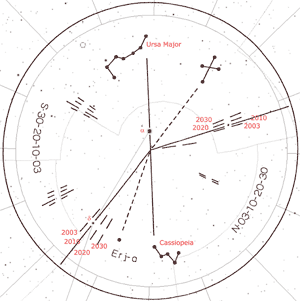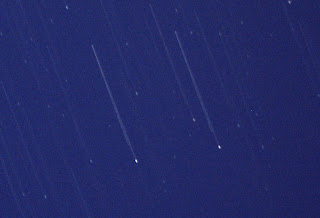Aligning a traditional GEM without any self alignment capabilities has got to be one of the most difficult things to do properly. Of couse now a days there are GOTO systems that do just about everything for you, but what to do when the mount standing in the livingroom corner is not one of those. There are a few ways of aligning the mount RA to the North Celestial Pole (NCP). Which way works for you depends on what your intetions for the observin session are. Below are described a few ways of doing the alignment.
You can just simply use the finder and the telescope to do the alignment to the NCP . It is actually easy to align the scope for visual observation this way. However, there is a catch, as always, if your mount RA and Dec axis are not perfectly perpendicular and your OTA mounted parallel to the to the RA axis, your RA axis is NOT pointing where it should. Only your OTA is. When this happens your target will eventually drift from view even with RA tracking.
You might have a mount with a Polar Alignment Scope fitted to the end of the RA axis. Using the PA Scope is easy and you get good alignment for visual work . Using this method you don't have to worry about the orientation of the OTA at all. The Polar Alignment scope views differ slightly for different manufacturers, but the basic idea is to adjust the Altitude and Azimuth adjustments so that Polaris, and possibly some other reference star, are located in marked positions in the PA scope field of view.
The third way of aligning is called drift alignment. Drift alignment is usually used to align permanently fixed mounts and movable mounts for astrophotography. There are different variations of drift aligning, but here I will concentrate on the traditional way and a simplified way that can be used to perform the alignment using a scope mounted DSLR.
Traditional drift align
The traditional dift align method can be performed either visually or using a webcam. When using a webcam, there are some software tools available to help with the procedure. One such piece of software is EQAlign, which is also free. The basic idea behind the drift align process is to adjust the Azimuth or Altitude while tracking a star at the local Meridian or due East. If you are doing the alignment visually you need an eyepiece with crosshairs (preferably double).
- The first thing to do is to level your mount and then perform a rough polar alignment of the mount by using a compass and setting the altitude to your latitude or by some other means at your disposal.
- Next you should point the scope at a star due South (local meridian) and stop the tracking motor if running. Note the direction of the motion of the star and rotate the eyepiece so that the star moves along one of the crosshairs. The direction of travel is West.
- Recenter the star on the crosshairs and start tracking. Monitor the drift of the star in the eyepiece. If the star drifts North, move Azimuth towards East and if it drifts South, move the Azimuth towards West. The longer you monitor the star, the better the accuracy.
- Next you need to find a star due east and perform the same routine there except you are adjusting the Altitude. If the star drifts North, adjust the altitude down and if the star drifts South adjust the altitude up.
- Repeat steps 2-4 until there is no more drift.
DSLR drift align
A variation of the drift align procedure can be performed with a DSLR connected to a computer. You will need software to control and view the images taken with the camera. There are various software tools that enable you to do this; Nebulosity, BackyardEOS and Astro Photography Tool to name a few (and MaximDL of course).
- Anyway, the basic idea is the same as with the traditional drift align method, but the DSRL align method utilizes the long exposure capability of the camera to get a good visual indication of the alignment error.The first thing to do is to level your mount and then perform a rough polar alignment of the mount by using a compass and setting the altitude to your latitude or by some other means at your disposal.
- Next you need to point the scope due South (local meridian) and keep the tracking running. You don't necessarily need bright stars since you will be using the camera to capture the photons so even faint stars are fine. You should set your camera to take at least 2 min exposures and use ISO setting of 1600 or more (these don't need to be pretty)
- Start the exposure:
- Let the mount track for the first 15s (this will give you a starting point)
- After 15s stop tracking or set tracking speed to lowest possible
- After 1 min of exposure set tracking to fastest possible
- As a result of the exposure you will get a star trail image that most likely looks like the letter "V". The orientation depends on your camera angle, but it doesn't matter. The purpose is to get the "V" in to a single line. You need to adjust the Azimuth either East or West depending on which way the "V" opens.
 |
| In this scenario my star trails drifted North, so I need to adjust my Azimuth East. (If you are wondering about the orientation of the trails; it's due to my camera angle) |
- After adjusting the Azimuth redo the exposure. If the "V" spreads you adjusted in the wrong direction. If it closes you adjusted in the correct direction. Continue repeating the exposures until you get a single line as a result.
 |
| After two adjustments of the Azimuth, the star trail is a single line (don't worry you'll soon figure out how much to move axis). |
- Next target either East or West and repeat steps 3-5 except this time adjust the Altitude.
 |
| Pointing East. My star trail has drifted North, so I need to adjust the altitude down. |
 |
| In the end the star trails are again lined up. |
- You should retry the Southern orientation to make sure that the Azimuth setting is still correct. If you have not leveled the mount with a bubble level or some other means, you should repeat the South and East/West adjustments as many times as needed to get the startrails to stay in line.
At least for me this method is easier and faster to do than the traditional way and I don't need to bring the webcam along. It can be performed with the imaging setup.
Clear Skies








0 comments:
Post a Comment